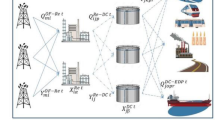Abstract
The present paper proposes two weighted goal-programming models for optimizing crude oil production in the middle and later periods of oilfield development. These models divide the oil yield optimization problem into two stages according to the characteristics of Chinese oil companies’ yield compositions. In the first stage, the total planned crude oil yield will be optimized by four sub-yields, while each sub-yield will be allocated optimally among different oil extract plants in the later stage. A case study is conducted to validate the proposed models. The results show that the model can address the annual crude oil yield planning subjectively. Moreover, the proposed model can rationally allocate resources among various extract oil plants and effectively reduce production costs in the context of ensuring planned oil yields.





Similar content being viewed by others
References
Aouni, B., Colapinto, C., & La Torre, D. (2014). Financial portfolio management through the goal programming model: Current state-of-the-art. European Journal of Operational Research, 234(2), 536–545.
Azmi, R. & Tamiz, M. (2010). A review of goal programming for portfolio selection. In: New Developments in Multiple Objective and Goal Programming (pp. 15–33). Springer.
Barzilai, J. (1997). Deriving weights from pairwise comparison matrices. Journal of the Operational Research Society, 48(12), 1226–1232.
Charnes, A., Cooper, W. W., & Ferguson, R. O. (1955). Optimal estimation of executive compensation by linear programming. Management Science, 1(2), 138–151.
Echeverria Ciaurri, D., Isebor, O. J., & Durlofsky, L. J. (2011). Application of derivative-free methodologies to generally constrained oil production optimisation problems. International Journal of Mathematical Modelling and Numerical Optimisation, 2(2), 134–161.
EIA. (2015). Annual Energy Outlook 2014 Early Release Overview. Washington.
Feng, L., Guo, D., Zhong, Y., Zhu, W., & Liu, C. (2009). Produciton composition optimization model based on multiple criteria and multi-constraint levels linear programming. Petroleum Planning & Engineering, 20(6), 14–20.
Gunnerud, V., Foss, B., McKinnon, K., & Nygreen, B. (2012). Oil production optimization solved by piecewise linearization in a Branch & Price framework. Computers & Operations Research, 39(11), 2469–2477.
Gunnerud, V., Foss, B., Nygreen, B., Vestbø R. & Walberg, N.C. (2009). Dantzig-Wolfe decomposition for real-time optimization-applied to the Troll west oil rim. In: ADCHEM conference (pp. 12–15).
Lai, Y.-T., Wang, W.-C., & Wang, H.-H. (2008). AHP- and simulation-based budget determination procedure for public building construction projects. Automation in Construction, 17(5), 623–632.
Liu, Z.-B., Ding, H., Gao, M., & Yang, Y.-H. (2004). Optimal model for oil production composition of oilfield development programming and its application. Acta Petrolei Sinica, 25(1), 63–65.
NBSC. (2012). National Bureau of Statistics of China. China statistical yearbook. Beijing: China Statistics Press.
Nygreen, B., Christiansen, M., Haugen, K., Bjørkvoll, T., & Kristiansen, Ø. (1998). Modeling Norwegian petroleum productionand transportation. Annals of Operations Research, 82, 251–268.
Ortuño, M. T., & Vitoriano, B. (2011). A goal programming approach for farm planning with resources dimensionality. Annals of Operations Research, 190(1), 181–199.
Schniederjans, M. J., & Garvin, T. (1997). Using the analytic hierarchy process and multi-objective programming for the selection of cost drivers in activity-based costing. European Journal of Operational Research, 100(1), 72–80.
Shakhsi-Niaei, M., Iranmanesh, S., & Torabi, S. (2014). Optimal planning of oil and gas development projects considering long-term production and transmission. Computers & Chemical Engineering, 65, 67–80.
Shang, M.-Z., Ge, Y.-J., Zhong, T.-X., & Li, S.-R. (2003). Non-linear optimal modeling of production manipulation and its application. Petroleum Exploration and Developmen, 30(4), 92–94.
Sharma, S., & Balan, S. (2013). An integrative supplier selection model using Taguchi loss function, TOPSIS and multi criteria goal programming. Journal of Intelligent Manufacturing, 24(6), 1123–1130.
Silva, T. L., & Camponogara, E. (2014). A computational analysis of multidimensional piecewise-linear models with applications to oil production optimization. European Journal of Operational Research, 232(3), 630–642.
Song, H.-C., & Li, Y. (2012). Researches and application of oil field production development plan model. Science Technology and Engineering, 12(7), 1611–1628.
Tian, C. (2014). China’s 2013 oil and gas imports/exports. International Petroleum Economics, 3, 29–41.
Willersrud, A., Imsland, L., Hauger, S. O., & Kittilsen, P. (2013). Short-term production optimization of offshore oil and gas production using nonlinear model predictive control. Journal of Process Control, 23(2), 215–223.
Xie, X.-J., Xiong, W.-L., Qu, H.-L., & Tao, L. (2008). Oil produciton composition bilevel programming model of oilfield and it’s application. Journal of Southwest Petroleum University (Science & Technology Edition), 30(2), 163–166.
Yan, J.-N., Hou, G.-T., Li, J.-J., Li, N.-W., & Lu, Y.-P. (2012). Economic efficiency forecast and latter appraises studies about mid and late period measure investment of oilfield development. Natural Gas Geoscience, 23(5), 973–977.
Acknowledgments
The authors gratefully acknowledge the financial support from the National Natural Science Foundation of China under Grant No. 71103016; the New Century Excellent Talents in University NCET-12-0952; and the China University of Geosciences (Wuhan) Takeoff Plan.
Author information
Authors and Affiliations
Corresponding author
Rights and permissions
About this article
Cite this article
Yu, S., Zhang, S., Agbemabiese, L. et al. Multi-stage goal programming models for production optimization in the middle and later periods of oilfield development. Ann Oper Res 255, 421–437 (2017). https://doi.org/10.1007/s10479-015-1866-9
Published:
Issue Date:
DOI: https://doi.org/10.1007/s10479-015-1866-9




